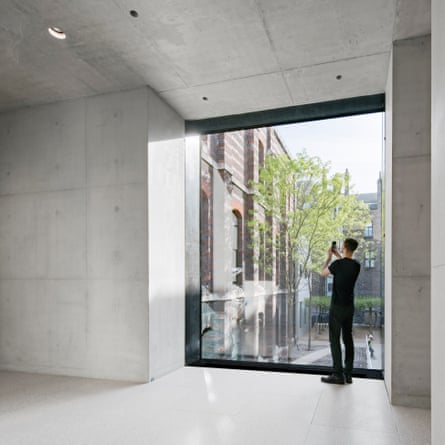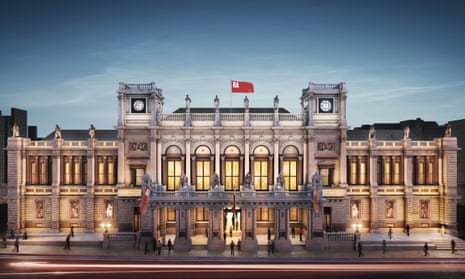Sometimes the most obvious things are hardest to achieve. It’s 20 years since the architect David Chipperfield proposed that a straight line would be the best way to get from the Royal Academy’s well-known premises in Burlington House, off Piccadilly, to 6 Burlington Gardens, a handsome Victorian building to its rear, into which the RA has just expanded. Only now, after abortive schemes by other architects proposed more roundabout routes, is this straight line about to open to the public.
From 19 May, it will take visitors from the academy’s existing entrance to Burlington Gardens, which was originally built for the University of London in 1870, unlocking one of the most significant expansions in the RA’s 250-year history. The work will increase its footprint by 70% and add new galleries, a 250-seat lecture theatre, education space, cafe-bar and space for the academy’s art school.
The aim, says Charles Saumarez Smith, the RA’s chief executive, is to take this venerable institution “and bring it back to what it’s supposed to be: an academy”. This means a multifaceted place not only of blockbuster exhibitions of David Hockney and abstract expressionism but also where students learn, where art is made and where the academicians, in theory the country’s most distinguished artists and architects, gather. “Most museums have objects but not much life,” says Chipperfield. “The RA has more life than you’d expect.”
The idea is not to consider art simply as finished products bought from auction houses “like canned vegetables” but as a process of creation. The RA Schools – formerly a distant rumour, at best, to most visitors to the academy – will become much more visible, with a gallery dedicated to showing artists’ work. The RA’s permanent collection of old masters, originally assembled to teach artists and students, will be on display.
Architecture, usually art’s poor relation in the RA’s priorities, will, thanks to a donation by Lloyd Dorfman, founder of Travelex, have its own gallery. There will also be at least one major architectural show per year. The increase in temporary exhibition space allows for a livelier rotation of shows and more work by living artists. The education room feels not like a dutiful afterthought, as such places often do, but a studio where children might truly enjoy creating things.
When it suits, Chipperfield is not afraid to make imposing buildings, such as his Hepworth gallery in Wakefield, or to work to an overriding set of ideas, but not here. “The RA didn’t need a lot of new architecture,” he said, “but diagnostic unlockings.” Much of the work is about getting 6 Burlington Gardens, which the RA says was “one of the grandest unrestored buildings in central London”, to function and to breathe.
Stone floors have been uncovered and juxtaposed with shiny new terrazzo. Skylights have been opened up. Except in the bar, where a multicoloured Victorian colour scheme has been recreated, the walls of the grand stairs and landings have been painted a cool, airy grey. Glimpses can be had into what was previously an obscure yard, now laid out by the landscape architects Wirtz to be both practical and pleasing. You might spot a student welding a sculpture there, or you might just enjoy looking at some trees.

Through the centre runs the new route, like a cross-section through the life and history of what Chipperfield calls a “sedimentary organisation”. Starting from the entrance hall to Burlington House, which was originally built as an aristocratic palace, it descends, by what were originally its garden steps, to the brick vaults beneath the main exhibition galleries above.
It is an upstairs-downstairs journey through both posh and functional spaces that, at one memorable and conceivably hazardous crossroad, intersects with the long corridor along which students move their artworks. It rises into 6 Burlington Gardens via a staircase encased in a meaty concrete bridge – one of the more emphatic pieces of new architecture in the £56m project – over the yard.
Then there is the lecture theatre, a calm, geometric space that, like a town square in a Mediterranean city, seems to make sense of the accumulated fabric around it. Chipperfield calls it “a room where people can talk”, not just a well-equipped technical facility, its semi-circular form derived from the shape of an ancient Greek theatre. Its concrete structure is visible beneath spare seating in leather and dark oak, again to give the sense of a classical outdoor space.
The totality of this new version of the Royal Academy, Burlington House plus Burlington Gardens, plus the new interventions, is diffuse, eventful, intriguing, sometimes beautiful. It is full of potential to serve an institution that Chipperfield calls “idiosyncratic” and “non-slick”. It can, as intended, enrich the range of the RA’s activities.
It will need to be curated with energy and wit. The inherited fabric generates unconventional and incidental spaces, which, handled right, could be revelatory. They also run the risk of feeling pointless, like the back stairs of some rambling country house into which less-loved heirlooms are shoved. The invigoration of these spaces could perhaps be guided by the architecture department, which would allow it to break out of the rather polite little gallery it has been assigned.
But the main thing is that, two decades after the RA first took on 6 Burlington Gardens, it and its public will now have full enjoyment of it. Chipperfield’s first proposal was in a competition that he lost to another practice, whose plans were then dropped as impractical and expensive. There was a second competition and a third, in 2008, which Chipperfield finally won.
The benefactors who fund museums and galleries, and often the managements of these institutions, generally love to attach their names to shining new extensions – whether or not they are actually needed – rather than subtle, incremental projects. So it’s refreshing to see such a project, which is what Chipperfield has given to the RA, break the habit.

Comments (…)
Sign in or create your Guardian account to join the discussion